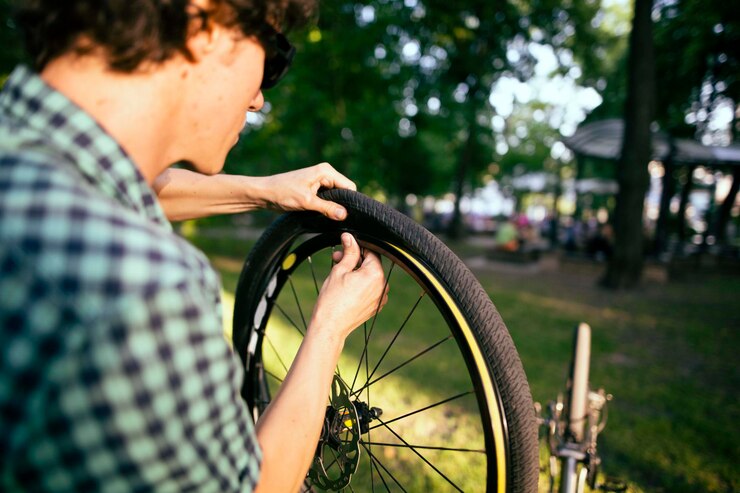Changing a bike tire may appear to be a difficult procedure, but with the appropriate instruction, it can be a manageable task that every biker should know. Whether you have a flat tire on a ride or want to improve the performance of your bicycle with fresh treads, understanding how to change a bike tire is an essential skill.
This comprehensive guide simplifies the process into five straightforward steps, ensuring you’re well-prepared to deal with unforeseen tire difficulties on the road or trail. By learning the ins and outs of tire replacement, you can have uninterrupted cycling adventures and improve your overall cycle performance.
Let’s look into the ins and outs of replacing a bike tire.
Tools Required
Tire Levers
These little, wedge-shaped tools are essential for pushing the tire sidewall away from the rim safely. They protect the inner tube while making tire removal and installation easier.
Pump
A reliable bike pump is essential for inflating your new inner tube to the required pressure. Proper inflation eliminates tire flats and improves ride pleasure.

Patch Kit / Spare Tube
A patch kit with adhesive patches enables you to fix small punctures in the inner tube, extending its life. A spare tube, on the other hand, is an immediate alternative for changing a broken tube while on the go.
Wrench / Quick-Release Lever
If your bike contains nuts that secure the wheel to the frame, you’ll need a wrench to loosen and tighten them. Quick-release levers on bicycles allow you to quickly remove and reinstall the wheel.
Soap / Lubricant
The use of soapy water or designated tire lubricant on the tire bead decreases friction during installation. This allows the tire to be placed onto the rim without causing harm to the tire or inner tube.
Before You Start
Correct positioning is essential when it comes to gaining access to a bike tire for maintenance or replacement. The two most typical methods are to turn the cycle on its side or to use an upright bike stand.

While it is possible to rest the bicycle upside down on its handlebars, several cyclists are concerned about possible handlebar and seat damage. As a result, picking the strategy that fits your level of comfort is important.
Another alternative is to purchase an upright bike stand, which elevates the bicycle off the ground and provides a stable platform for work. When lying the cycle on its side, make sure the chain side is facing up for a smoother process.
Furthermore, for those attempting rear tire replacement, changing gears to the smallest ring ahead of time will greatly facilitate tire removal. The combined effect of positioning alternatives and gear modifications improves the speed of your bike repair or replacement chores.
How to Change a Bike Tire?
1. Remove Wheel
Begin by getting your bike ready for work by turning it upside down or using a bike stand. If your cycle has rim brakes, disconnect the cable by pressing the brake arms together. There is no need to alter disc brakes.

Loosen the nuts on the axle of the wheel you want to remove with a wrench or your fingers. Open the quick-release lever on your bicycle. Pull the wheel gently out of the dropouts on the bike frame. Maintain a record of any washers or spacers you remove.
2. Remove Tire
By pressing the valve stem, you can fully deflate the tire. Lift one side of the tire bead away from the rim with tire levers. To keep the lever in position, hook it onto a spoke. Wrap the lever around the rim and pull the tire bead off.
Repeat on both sides until one tire bead is off the rim. Remove the inner tube from the tire with care. Make sure not to damage the tube while doing so.
3. Clean Inside and Check Wheel
Examine the inner part of the tire for dirt, glass, or sharp things that could have caused the flat tire. To avoid future flats, remove any additional objects. Also, look for any sharp edges or bulges on the rim that could puncture the tube.
If you find any, sand them down carefully with fine sandpaper. This process guarantees that the new tube will not be damaged.
4. Put Tire Back On
To shape the new inner tube, partially inflate it. The valve should be inserted through the valve hole in the rim. Begin putting the tire back onto the rim by placing one bead of the tire onto the rim with your hands.
Work your way around the rim, using your fingers or tire levers as needed, to get the entire tire bead onto the rim. Make sure not to pinch the inner tube between the tire bead and the rim.
5. Reinsert Wheel
Install the wheel into the dropouts on the bike frame with care. Check that the chain is in the correct gear, which is usually the smallest rear cog. Align the brake pads with the rim if you have rim brakes.

The axle of the wheel must be fully seated in the dropouts. Tighten the screws or fasten the quick-release lever according to the design of your bicycle. Check to ensure that the wheel is centered and secure.
How to Change a Bike Tire?
Take Precautions
- Use tire levers carefully to avoid pinching or damaging the inner tube.
- Be careful not to overtighten the axle nuts, since this can harm the wheel and frame.
- To avoid future flats, take your time, ensuring the tire bead is properly set on the rim.
- If you’re not sure how to put back the wheel correctly, consult a bike mechanic or a guidebook.
Why Are Some Tires Harder to Install Than Others?
In general, the difficulty or ease of installing cycle tires is a consequence of a complex combination of factors. Tire design is important because tires with denser, harder beads need more effort due to their resistance.

Similarly, the design of the rim, whether narrow or deep, adds to the difficulty, as some rims may interfere with smooth bead placement. Tire size and composition can play a role, with larger sizes and tougher compounds potentially offering more resistance.
Furthermore, the interaction of experience, technique, and tools used affects the installation procedure. Cold temperatures, for example, might add another layer of complication.
Recognizing the combination of elements enables bikers to approach tire installation with accuracy, preparing them to conquer obstacles efficiently.
Tips for Installing Tight Bike Tires
Dealing with tight-fitting bike tires requires a strategic approach. Warm the tire and inner tube to increase their flexibility. Make use of high-quality tire levers that are soft on the rim and tire.
For a smoother setup, lubricate the tire bead with soap or tire lubricant. Begin by seating one side of the tire onto the rim, then apply controlled pressure to the opposing side. Tilt the wheel against a sturdy surface or your legs to use your body weight.

Check the location of the rim tape twice and be patient throughout the process. Following these instructions assures a smooth installation of tight bicycle tires, making the task more doable and enjoyable.
How Much Time Does the Process of Changing a Bike Tire Take?
The time it takes to change a bike tire is determined by confidence, equipment, and skill. It can take 15 to 20 minutes for experienced cyclists. Beginners may need 30 to 45 minutes, to learn through practical experience.
Time depends on factors such as tire type, removing complexities, and any unforeseen obstacles. Regular practice and expertise in these steps can substantially speed up the process.
Prioritize accuracy over quickness, as rushing can lead to errors. Finally, patience is rewarded with improved cycling maintenance abilities and a smoother riding experience.
Conclusion
Hope you have learned how to change a bike tire. To avoid bending a bicycle’s wheel, always replace or repair any tire damage as soon as possible.
Also, maintain track of all minor pieces, such as nuts, lock rings, or valve caps, during the repair or replacement procedure. Although they are small, their function is critical to the bicycle’s operation, and losing one during a repair can cause another issue that must be fixed before the bike can be used again.
FAQs
For any tire, the procedure is the same. The wider the tire, the easier the task. Road bike tires can be difficult to maintain and may require more attention.
This cost includes the inner tube, sealant, and tires. Inner tube tires typically cost $10-$20 for labor, whereas tubeless tire repairs can cost $20-$30 due to complexity and time.
Replace worn-out tires with several tiny cuts or punctures. Tire lifespan varies between 500 and 5000 miles depending on discipline and quality.
They might cost as little as $20 or as much as $100. It is determined by puncture resistance, tire weight, and performance.



